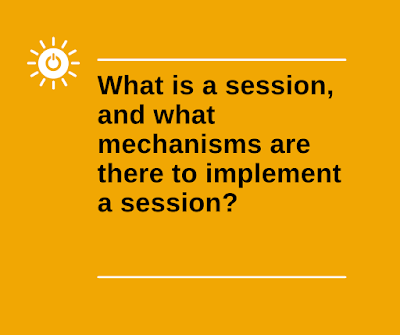Today we will answer 3 questions
What is a cookie and what is the process of using a cookie?
What is a session, and what mechanisms are there to implement a session?
What is the difference between session and cookie?
What is a cookie and what is the process of using a cookie?
Since the http protocol is a stateless protocol, if the
client does not have a mechanism to save the user's access state when accessing
the web application through the browser, it will not be able to continuously
track the operation of the application. For example, when a user adds a product
to a shopping cart, the web application must save the state of the shopping
cart while the user browses other products, so that the user can continue to
add products to the shopping cart.
Here are the most common login cases to explain the cookie
usage process:
First, the user initiates a login request to the server in
the client browser.
After the login is successful, the server will set the login
user information in a cookie and return it to the client browser. After the client
browser receives the cookie request, it will save the cookie locally (It may be
memory or disk, depending on the specific usage.) When the web application is
accessed again in the future, the client browser will bring the local cookie
with it, so that the server can obtain user information based on the cookie
What is a session, and what mechanisms are there to
implement a session?
A session is a mechanism for maintaining a session between
the client and the server. But unlike cookie storing session information
locally on the client, session keeps the session on the browser side.
We also use the login case as an example to explain the
usage process of the session:
First, the user initiates a login request in the client
browser.
After the login is successful, the server will save the user
information on the server and return a unique session identifier to the client
browser.
The client browser will save this unique session identifier.
When accessing the web application again in the future, the
client browser will bring this unique session identifier, so that the server
can find user information based on this unique identifier.
Seeing this may cause questions: return the unique session
identifier to the client browser, then save it, and bring it with you when you
visit later, isn't this a cookie?
Yes, session is just a session mechanism. In many web
applications, the session mechanism is implemented through cookies. That is to
say, it only uses the function of the cookie, and does not use the cookie to
complete the session preservation. Contrary to the mechanism in which the
cookie saves the session on the client side, the session saves the session
information to the server through the function of the cookie.
Furthermore, session is a mechanism for maintaining a
session between the server and the client, and it can be implemented in different
ways. Take the more popular small programs as an example to illustrate the
implementation of a session:
First, after the user logs in, the user log-in information
needs to be saved on the server side. Here we can use redis. For example,
generate a userToken for the user, then save it to redis with userId as the key
and userToken as the value, and bring the userToken back to the applet when it
returns.
After receiving the userToken, the applet will cache it, and
bring the userToken with it every time it accesses the back-end service.
In subsequent services, the server only needs to compare the
userToken brought by the applet with the userToken in redis to determine the
user's login status.
What is the difference between session and cookie?
After the explanation of the above two questions, this
question is very clear
1)
Cookie is a caching mechanism provided by the browser.
It can be used to maintain the session between the client and the server.
2)
Session refers
to a mechanism for maintaining the session between the client and the server.
It can be implemented through cookies or through Realize by other means.
If a cookie is used to implement the session, the session
will be saved in the client browser and the session provided by the session
mechanism is saved on the server.

Comments
Post a Comment